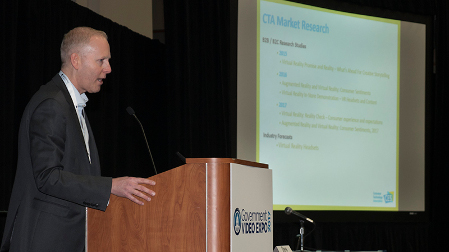GV Expo: CTA Offers Look Into Virtual Future
WASHINGTON—The promise of a future of virtual and augmented reality and artificial intelligence is not just a pipedream but is here and now and is revolutionizing our daily activities.

That was the word from Steve Koenig, senior director of market research for the Consumer Technology Association, in his presentation to the 2017 GV Expo. Koenig described a future where VR/AR and AI will bring immersive experiences that could alter how consumers define “reality.” These technologies have practical applications beyond the gaming and entertainment sectors, as Koenig described a virtual future where VR could replace face to face meetings and help veterans overcome post traumatic stress disorder, for example.
“Presence—remember that word,” Koenig said. “VR delivers a sense of presence with this experience that we've never seen before.”
Koenig noted that falling prices will soon kickstart VR, citing Facebook’s recent introduction of Oculus Go, a self-contained unit that retails for less than $200. “They want to get VR in a billion peoples' hands, which seems a big number but is actually quite modest when you think about how many users Facebook has globally,” he said.
BEYOND ENTERTAINMENT
Health care is another area where VR will be a tremendous asset, Koenig said. Project Bravemind, a project developed by researchers at USC, allows counselors and physicians to use VR to help victims of PTSD recreate traumatic experiences to cope and eventually recover. “[Project Bravemind] is an application that I think is really meaningful when it comes to serving our veterans and doing right by them,” Koenig said.
Over the past decade, numerous historical sites and materials have been destroyed by religious extremists in the Middle East and VR can help archaeologists develop virtual environments that recreate what has been lost. “Those sites are gone forever, but thanks to VR we can record and render what they actually would have looked like,” Koenig said. “You can virtually tour them, and we can virtually document them in an immersive way, but we can also render what they would have looked like way back when.”
Virtual meetings are also beginning to replace face to face interactions, Koenig noted. “This is going to start to happen more and more either in more of a casual sense, but also for business reasons,” he said. The concept of virtual trade shows has been around for more than a decade but VR could greatly alter and accelerate the move to virtual meetings in the near future. “In five years there will be an opportunity to have a virtual element of [trade shows], so people who couldn't attend could actually virtually attend the same trade show using VR,” Koenig said.
AI AND IOT
Koenig also touched on artificial intelligence, a technology that stirs both optimism and concern among consumers as well as businesses, and for varying reasons. He described the differences between “narrow AI,” characterized by popular consumer products like Amazon Alexa and Google Home, which use algorithms to determine such things as recommendations and give weather forecasts and “general AI” that is more complex, using machine learning to do tasks in real time, such as operating autonomous vehicles. Koenig used the HAL 9000 from “2001: A Space Odyssey” to illustrate what general AI is, adding “we’re a decade away from that, and the good news is that by the time we get there, I think we’ll figure out how to incorporate those systems into our society and our economies.”
All of these technologies are being connected via the Internet of Things, which is the concept of using IP to allow connected devices to communicate with each other. Keonig warned attendees to not think of IoT as a “trend,” but as a technology that is here and now, using the “smart home” concept as an example. Koenig noted that sales of smart home devices such as Alexa and Google Home have surpassed $1 billion in revenue so far this year.
“IoT is a connected revolution, the likes of which we have not seen this kind of change in our culture, to our society, to our economy, our whole way of life, since the industrial revolution,” Koenig said.
Get the TV Tech Newsletter
The professional video industry's #1 source for news, trends and product and tech information. Sign up below.
Tom has covered the broadcast technology market for the past 25 years, including three years handling member communications for the National Association of Broadcasters followed by a year as editor of Video Technology News and DTV Business executive newsletters for Phillips Publishing. In 1999 he launched digitalbroadcasting.com for internet B2B portal Verticalnet. He is also a charter member of the CTA's Academy of Digital TV Pioneers. Since 2001, he has been editor-in-chief of TV Tech (www.tvtech.com), the leading source of news and information on broadcast and related media technology and is a frequent contributor and moderator to the brand’s Tech Leadership events.

